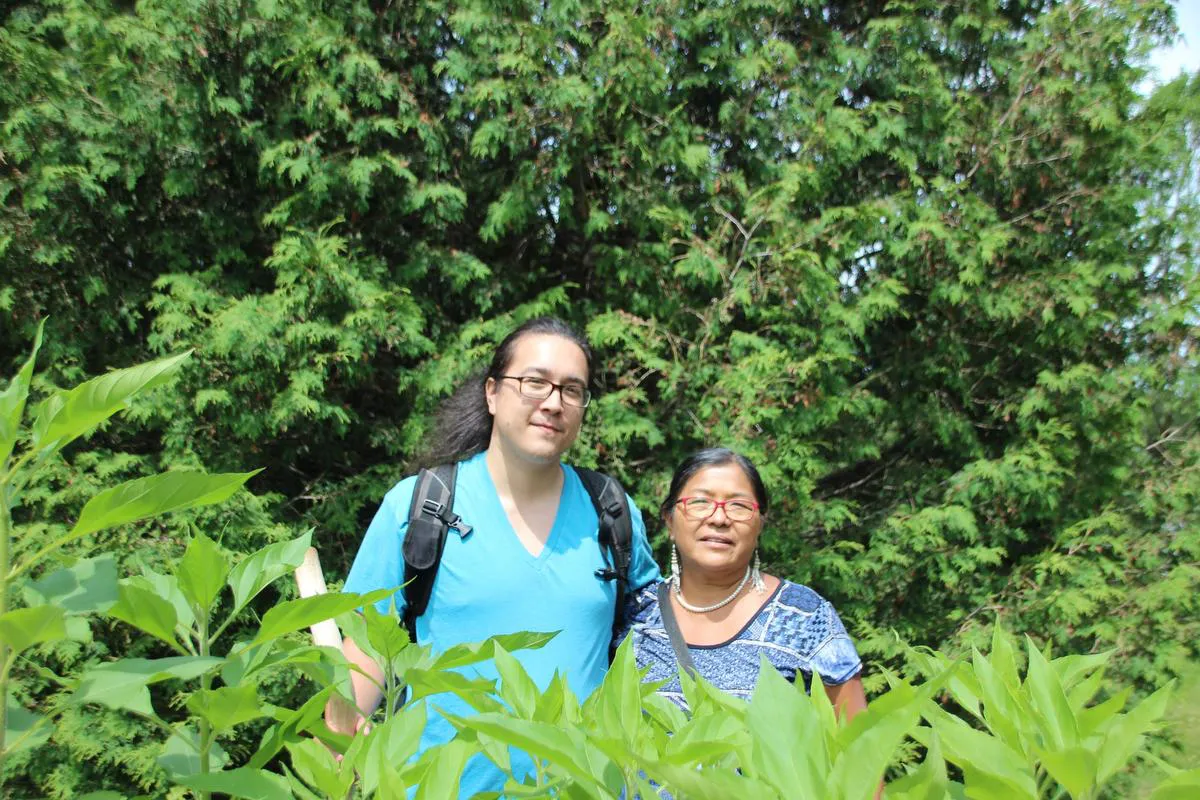On a guided medicine walk through the new Wabanaki Healing Garden at the Fredericton Botanic Garden, Cecelia Brooks points out three varieties of plantain, a plant used in traditional medicine for treating cuts and bites. One is native to North America; the others arrived with Europeans.
“They called it ‘white man’s footprints’ because wherever settlers would walk, we’d find plantain,” says Brooks. She and her son, Anthony Brooks, founded Wabanaki Tree Spirit Tours & Events in 2019. They’ve been working on this garden for three years. In June, they hosted its official opening.
When I ask how plants introduced to North America by settlers can be considered traditional, she replies, “Many plants that come from Europe became incorporated into our pharmacopoeia. We’ve been here since the time of the glaciers. Adaptation is inherent to who we are.”
In response to growing awareness of Indigenous issues and interest in Indigenous culture, Cecelia Brooks and other tourism operators across the Maritimes, or Mi’kma’ki, are adapting by offering a range of authentic experiences to visitors, and to their own communities.
For Brooks, the incentive to adapt to this new environment came in the form of public demand and a request from the City of Fredericton. She’s well known as the operator of Soul Flower Herbals at the Fredericton Boyce Farmers Market, where she puts her Indigenous roots and her chemistry background to work selling plant extracts. “Our biggest ask at the market has been, ‘Would you take us on a medicine walk?’” she explains.
Shortly after she and her son started Wabanaki Tree Spirit Tours to meet this demand for guided walks that explore medicinal plants, Fredericton officials asked Brooks if they would design and build a garden.
The result is the Wabanaki Healing Garden, which is constructed in the shape of a medicine wheel and filled with nearly 50 plants they collected from across the province. Meant to offer a place of healing for individuals, the garden will also be the site of educational workshops and community programming.
The City of Fredericton is just one of many players working to support Indigenous tourism in the Maritimes. Steve Paul names half a dozen Indigenous and government organizations at every level that helped establish First Nations Tourism, the company he and his wife, Florence, founded in 2019 in the New Brunswick community of Metepenagiag.
“I always had a dream of owning my own business and making it grow,” he says. “I’m now living that dream.” On a recent trip to Metepenagiag, I join some of Paul’s authentic Mi’kmaq tours, starting with a guided kayak paddle on the Little Southwest Miramichi River past the Oxbow National Historic Site.
Today, Oxbow is a forested bend in the river, but 3,000 years ago, this place was buzzing with activity. “Millions of salmon would’ve been going upriver,” says Paul as we drift in the gentle current. “The riverbank was full of teepees and thousands of people, bustling and hustling, preparing food for the community to survive the winter.”
As Paul describes the scene, I can almost smell the salmon and sturgeon smoking over fires, hear the voices of his ancestors and see Mi’kmaq fishing from birchbark canoes, landing and preparing their catch, and teaching their children to do the same.
The next day, Paul takes me fly fishing for salmon, teaching me how to cast and where to set the fly in the river’s current, some of the skills his father taught him. I think of fly fishing as the contemporary version of the fishing that Paul’s ancestors did here 3,000 years earlier, a heritage the Metepenagiag community only recently rediscovered.
As Indigenous tourism operators offer new experiences like these, they are relearning lost or half-forgotten history, traditions and skills, and bringing them back to their communities.
In Nova Scotia, renowned artisan Todd Labrador builds a birchbark canoe every summer at Kejimkujik National Park. As the only Mi’kmaw practising the craft today, he’s built canoes in Indigenous communities and as far away as France.
Labrador learned the basics from his father, Charlie Labrador, who learned by watching his own father, Joe Jeremy Labrador, who built his last canoe in 1961, when Charlie was just five years old. Todd Labrador learned the rest by doing.
Relearning and teaching Indigenous traditions are major motivations for Labrador and others. “We don’t have the Elders to teach these things anymore,” he says, “but the material will teach you.”
As he shows me how to split a spruce root into sinewy twine for binding the bark to the canoe frame, he adds, “In the beginning, it was the root, the tree, the bark that taught my ancestors.”
It’s a sentiment I hear echoed by Paul. “A lot of our people have lost their traditional ways,” explains Paul. “I like doing this because it allows me to reconnect with who I am as an Indigenous person.”
Reconnecting with her indigeneity is something Brooks is hoping to pass on to others. “In this reconciliation process that Canada is undergoing, it’s incumbent upon us to teach people who want to learn,” says Brooks. “My son and I feel that the best way for them to learn is from us.”
Writer Darcy Rhyno travelled as a guest of Tourism New Brunswick and Tourism Nova Scotia, which did not review or approve this article.
JOIN THE CONVERSATION
Credit: Source link


















:format(webp)/https://www.thestar.com/content/dam/thestar/life/travel/2022/08/19/relearning-reconnection-reconciliation-mikmaq-tourism-operators-are-offering-authentic-experiences-to-visitors-and-to-their-own-communities/binding_bark_onto_canoe_frame_credit_darcy_rhyno.jpg)













